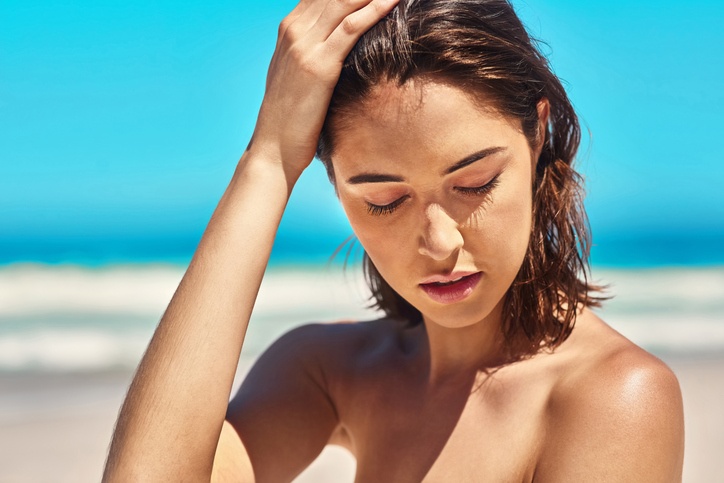In partnership with SA’s top medical aesthetic companies
Your essential ally in protecting your assets is sunscreen, but not all are created equal, and they’re only as effective as how you use them. Here’s what you need to know.
Wrinkles, dark spots, leathery, sagging skin… all telltale signs of deep-seated damage inside our skin cells caused by years of sun exposure, and one of the main reasons we should all be sun smart, and one of the reasons we should all wear sunscreen, both summer and winter, from childhood. After all, prevention is always better than cure.
Sunlight physically damages (breaks apart) or mutates skin cell DNA over time. Ultraviolet (UV)A also penetrates down into the deepest layers of the skin to break down the support, resulting in volume and elasticity loss, while UVB triggers the production of pigment within the skin which causes a tan, freckles, sunspots and, in some cases, may lead to skin cancer.
We can’t – and shouldn’t – avoid sunlight completely, as we need it for vitally important vitamin D production, but we only need 10 minutes, twice a week, of unprotected exposure to an area the size of our forearms to activate this.
The rest of the time, we need to get into Sun smart habits (link to story 1), and that involves using an effective sunscreen. We do the homework for you.
What should you look for?
Your ideal sunscreen should offer
- Protection against UVB and long-wave UVA – look for this on the bottle or the word Broadscreen or broadspectrum, meaning both
- Have antioxidant properties against Reactive Oxygen Species (free radicals)
- Use stable and safe sun filters
- Some of the newer formulas also contain enzymes that activate cell DNA repair systems
Physical sunscreens form a physical shield on the skin and block or reflect the sun’s rays. Read your label. They should contain both zinc oxide and titanium dioxide, which cover both the UVB and UVA spectrum.
Chemical sunscreens absorb the sun’s rays and neutralise them. There has been much controversy about the chemical filters used in sunscreen. For example, avoid the chemical oxybenzone, a synthetic oestrogen that penetrates beyond the skin into the body. Instead, look for safe and stable active ingredients such as zinc, titanium, avobenzone, Tinosorb or Mexoryl SX. These protect skin from harmful UVA radiation and remain on the skin, with little, if any, penetrating into the body.
Good to know There is no such thing as a total sunBLOCK, it’s only sunSCREEN – you should use between SPF 30 and SPF 50+, depending on how fair you are.
Sunscreens have come a long way. Modern formulations cater for all skins (oily, dry, sensitive), lifestyle needs (stick, clear spray, etc.) and texture preferences (milk, compact powder, cream…), and won’t leave you shiny or cause breakouts. Oily skins may prefer a gel or mineral powder. The latter works very well over make-up and is easy to re-apply. Lotions and creams favourite for dehydrated skin types.
Here are our top picks
The new generation of sunscreens go well beyond mere UV protection…
- Lamelle Helase 50 transcends the realm of sunscreens by being the first photo-protecting and correcting product to offer full-circle protection and DNA repair across the entire spectrum of sunlight in a single product. Helase 50 combines its revolutionary full-spectrum photoprotection with the ability to combat photoageing by blocking collagen-killing MMPs, boost photoimmunity, stem oxidative stress and neutralise reactive oxygen species using the most powerful antioxidant available, Pycnogenol®. Helase 50 not only employs 80GG–1 to boost your body’s NER systems’ ability to correct DNA damage, but also uses the recently discovered DNA-correcting enzyme photolyase to give your body the never-before-seen ability to repair the kind of damage it cannot correct by itself: dimers. It’s possibly the most powerful photo-protection and DNA-correction product in South Africa, if not the world.
- Genop’s Spanish brand Heliocare is based on patented potent antioxidant technology called FERNBLOCK, which has an impressive 42 clinical studies on its sun-protection efficacy and safety both as an oral supplement as well as in cream form. Heliocare should be classified a photoimmunoprotectant (phew!), not just a sunscreen, as it offers 4 levels of protection over and above UVA/UVB protection: Antioxidant, Immunological, Cellular DNA and Photoageing – protecting fibroblasts and collagen from UV damage. Suitable for all skin types, with normal and oil-free formulations, Heliocare’s wide offering will please everyone:
Gel Products: Oil-free Gel SPF50, XF Gel SPF50, Silk Gel SPF30, Spray SPF50 (water-resistant)
Tinted sunscreens SPF50: Compacts (3 shades, normal/oil free), Tinted Gel Colours (2 shades)
- Obagi Professional-C Vitamin Suncare SPF 30 has a dual protection action against UV radiation and visible and infrared rays. It contains 10% L-Ascorbic Acid (Vitamin C), a powerful antioxidant against free-radicals, which also brightens the skin and improves visible signs of ageing. Suitable for all skin types including sensitive skin, it has a light texture which allows it to absorb quickly, leaving no white residue or greasy film, and it leaves your skin silky and hydrated. Paraben-free and it won’t block pores.
- The plus factor. Oral antioxidant supplements such as those from Ovelle or Heliocare offer added protection against the sun, but should always be used with sunscreen product. They are very handy when you know you’re going to be having excessive sun exposure as they provide additional antioxidant protection against UV damage.
Shop online for all these products at https://onlineskinshop.co.za.
To find out more about protection against the sun and to find suitable treatment solutions after the damage was done by visiting Skin Renewal on www.skinrenewal.co.za or contact 0861 SKIN SA (754 672).
